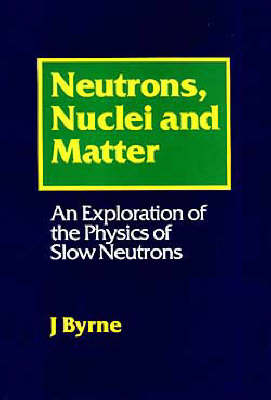Dover Books on Physics
1 total work
Neutrons, Nuclei and Matter is an encyclopedic work of reference covering almost every conceivable aspect of neutron physics. This is a major compilation of fundamental properties and interactions, detailing both the neutron's role as a major element in tests of the Standard Model of astro-particle physics and its use in nuclear energy generation and the study of condensed matter systems.
* Comprehensible and accessible treatment of all areas of neutron physics
* Overview of the current theoretical and experimental status of the whole of neutron physics
* Comprehensive reference list and bibliography with over 1500 entries summarising important papers on neutron physics
* Comprehensive index, making the book very accessible
The author, inventor of the Penning trap method for determining neutron lifetime, has produced a book that will interest anyone who uses the neutron as a research tool or who attempts to investigate its nature either experimentally or theoretically. Jim Byrne has worked in neutron physics and allied areas for over thirty years and is a world authority in the field.
Books written on neutron physics traditionally fall into two classes. Either they deal mainly with the interactions of neutrons with nuclei, covering subjects such as slow scattering, Breit-Wigner resonance theory, nuclear fission and energy production, or they devote themselves to the applications of neutron scattering in studies of condensed matter and magnetic systems. In both cases, the neutron is viewed as a tool but is not itself the main topic of interest. Neutrons, Nuclei and Matter is different; in particular it includes a detailed treatment of the strong, weak and electromagnetic properties of neutrons, which in recent years have provided major areas of research for the testing of the predictions of the Standard Model of particle physics. Parallel developments in cosmology and astrophysics are also explored.
The book looks at the growth in interest in the wave properties of neutrons following the development of the perfect crystal interferometer, and the way that this instrument has made it possible to demonstrate quantum behaviour very directly.
Around a fifth of the material in Neutrons, Nuclei and Matter is about the generation of nuclear energy from fission and fusion sources, which is treated from an analytical rather than a technological viewpoint. The middle section gives an extended discussion of neutron optics, concluding with a review of the applications of elastic and inelastic neutron scattering in materials technology. The final fifth of the volume is devoted entirely to the fundamental role the neutron plays in today's particle physics, stressing its potential for bringing to light new phenomena beyond the Standard Model.
Everything has been placed in context within science as a whole, with discussion of the origins of different ideas and considerable attention to historical detail.
Neutrons, Nuclei and Matter is a reference work that every physics department and main library should have in its collection.
* Comprehensible and accessible treatment of all areas of neutron physics
* Overview of the current theoretical and experimental status of the whole of neutron physics
* Comprehensive reference list and bibliography with over 1500 entries summarising important papers on neutron physics
* Comprehensive index, making the book very accessible
The author, inventor of the Penning trap method for determining neutron lifetime, has produced a book that will interest anyone who uses the neutron as a research tool or who attempts to investigate its nature either experimentally or theoretically. Jim Byrne has worked in neutron physics and allied areas for over thirty years and is a world authority in the field.
Books written on neutron physics traditionally fall into two classes. Either they deal mainly with the interactions of neutrons with nuclei, covering subjects such as slow scattering, Breit-Wigner resonance theory, nuclear fission and energy production, or they devote themselves to the applications of neutron scattering in studies of condensed matter and magnetic systems. In both cases, the neutron is viewed as a tool but is not itself the main topic of interest. Neutrons, Nuclei and Matter is different; in particular it includes a detailed treatment of the strong, weak and electromagnetic properties of neutrons, which in recent years have provided major areas of research for the testing of the predictions of the Standard Model of particle physics. Parallel developments in cosmology and astrophysics are also explored.
The book looks at the growth in interest in the wave properties of neutrons following the development of the perfect crystal interferometer, and the way that this instrument has made it possible to demonstrate quantum behaviour very directly.
Around a fifth of the material in Neutrons, Nuclei and Matter is about the generation of nuclear energy from fission and fusion sources, which is treated from an analytical rather than a technological viewpoint. The middle section gives an extended discussion of neutron optics, concluding with a review of the applications of elastic and inelastic neutron scattering in materials technology. The final fifth of the volume is devoted entirely to the fundamental role the neutron plays in today's particle physics, stressing its potential for bringing to light new phenomena beyond the Standard Model.
Everything has been placed in context within science as a whole, with discussion of the origins of different ideas and considerable attention to historical detail.
Neutrons, Nuclei and Matter is a reference work that every physics department and main library should have in its collection.
